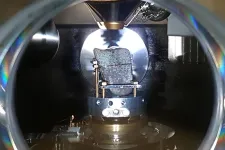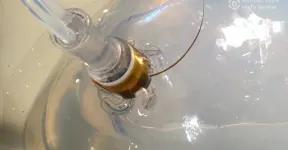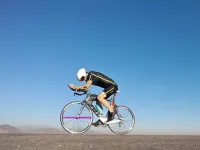(Press-News.org) Research Highlights
Abdominal aortic aneurysm, a weakening and ballooning of the aorta, the largest blood vessel in the body, may result in a life-threatening rupture.
In a small, preliminary study examining a potential treatment to keep small abdominal aortic aneurysms from growing to a dangerous size, intravenous administration of immune-modulating cells resulted in a significant decrease in pro-inflammatory cells, and with higher doses, there was a decrease in aneurysm size.
In a separate small study, people with abdominal aortic aneurysms were far more likely to have their aneurysms grow rapidly if they reported a previous COVID-19 infection.
Embargoed until 2 p.m. CT/3 p.m. ET Wednesday, May 10, 2023
BOSTON, May 10, 2023 — The intravenous delivery of immune-modulating cells may someday slow the expansion of bulges in the aorta, known as abdominal aortic aneurysms. A second study found evidence that a COVID-19 infection may promote the enlargement of these dangerous bulges. These preliminary studies were presented at the American Heart Association’s Vascular Discovery: From Genes to Medicine Scientific Sessions 2023. The meeting, held May 10-13, 2023, in Boston, is a premier global exchange of the latest advances in new and emerging scientific research in arteriosclerosis, thrombosis, vascular biology, peripheral vascular disease, vascular surgery and functional genomics.
The aorta is the body’s largest artery, and the abdominal aorta is around 2 cm (0.79 inch) wide – roughly the width of a garden hose. The abdominal aorta leads away from the heart and carries oxygen-rich blood to the lower part of the body. An abdominal aortic aneurysm occurs when the aorta weakens and develops a bulge. When the bulge enlarges far beyond its normal size, it is extremely dangerous and potentially fatal.
According to the American Heart Association’s 2023 statistics, the 150,000 global deaths attributable to aortic aneurysms in 2020 represented a 26% increase from 2010, which was slightly higher in women compared with men. Rates of rupture were also higher among people who were smokers and women.
“Anyone who has ever over-inflated a balloon knows that too much pressure is likely to cause a rupture. In the aorta, this creates a true medical emergency, because approximately 70% of people will die before they reach the hospital, and 50% of those who make it to the hospital will die from blood loss before any intervention is possible,” said Humraaz S. Samra, M.B.B.Ch., B.A.O., lead author of the study (abstract 111) and a resident in integrated vascular surgery at the Indiana University School of Medicine in Indianapolis.
Depending on its size, after an abdominal aortic aneurysm is diagnosed, surgical repair may be recommended right away, or the aneurysm may be monitored over time, with intervention taking place before it reaches a rupture-prone size, according to researchers. When aneurysms are small, no medication has been proven to keep them from enlarging, however, these patients are advised to stop smoking and to take medications to manage high blood pressure if they have it, Samra explained.
Inflammation is increasingly thought to play a significant role in the development and early growth of abdominal aortic aneurysms. When there is a breakdown in the supportive structure of blood vessels (which evidence suggests is likely caused by smoking), proteins break down and their remnants are released into the bloodstream. The body recognizes these particles as foreign objects and activates the immune system to protect itself, promoting inflammation in the area.
In this study, Samra and colleagues investigated whether immune-modulating cells, called mesenchymal stromal cells, a type of stem cell, from a healthy donor administered to a patient with a small abdominal aortic aneurysm might create a less-inflammatory environment and slow the growth of the aneurysm.
“We believe that a defect in the expression of an anti-inflammatory immune cell called interleukin (IL)-10 is a key event in the formation of abdominal aortic aneurysms. We have confirmed in lab studies that mesenchymal stromal cells have the potential to turn into cells that are profoundly anti-inflammatory and secrete copious amounts of IL-10 when under the right experimental circumstances,” Samra said.
The researchers enrolled 28 adults with small abdominal aortic aneurysm (average age of 66 years; all men) in the study. Six participants were given a low concentration of mesenchymal stromal cells, the low-dose group; 10 patients received a higher concentration of mesenchymal stromal cells, the high-dose group; and 12 patients received a placebo. For four weeks after the intravenous administration of the mesenchymal cells or placebo, the researchers tracked changes in levels of immune cells and the ratio of a few select types of highly inflammatory immune cells (T-helper 17, or Th17) to another immune cell (T regulatory type 1, or Tr1), which secretes large amounts of anti-inflammatory signaling molecules called IL-10s. Changes in abdominal aortic aneurysm size were calculated one year after treatment.
The analysis found:
The mesenchymal stromal cells were safe, causing no allergic reactions in any of the study participants.
Seven days after treatment, there was a significant increase in the concentration of anti-inflammatory IL-10 among participants in both the high- and low-dose mesenchymal stromal cell groups compared with the placebo group.
At day 14, there was a significant decrease in the percentage of inflammatory Th17 cells in both the high- and low-dose mesenchymal stromal cell groups compared with the placebo group.
At day 30, there was a significant improvement in the ratio of anti-inflammatory to pro-inflammatory cells in the high-dose mesenchymal stromal cells group compared with the placebo group; however, the difference between the high-dose and the low-dose mesenchymal stromal cell group did not reach statistical significance.
At one year, there was a decrease in aneurysm size among the participants in the high-dose mesenchymal stromal cell group compared with the placebo group, however, the difference did not reach statistical significance.
“These data are very promising but still early. We hope to obtain more data to develop clinical trials and hopefully change treatment paradigms, more research needs to be done but we have an exciting start!” Samra said.
In a separate study also to be presented at the meeting (abstract 280), another group of researchers explored whether COVID-19 infection might influence the growth of abdominal aortic aneurysms. They evaluated the yearly growth rate of abdominal aortic aneurysms in 175 adults (average age of 77 years; 80% male; 67% white; 78% past or present smokers) who had at least two measurements of their aortic diameter taken in 2020 to 2021 and recorded in the Stanford Research Repository Database.
Researchers compared 26 people who had previously tested positive for COVID-19 with 149 people who had not had COVID-19. Two aortic imaging/diameter measurements were performed in both groups. Prior COVID-19 infection timing varied from weeks to months before the tests were completed.
The analysis found:
Participants who reported a previous COVID-19 infection were 9.7 times as likely to have rapid abdominal aortic aneurysm growth (higher growth than the average of 2.7 mm per year). The average size of the abdominal aorta is 2 cm (0.79 inch).
Factors that appeared to increase the risk of rapid abdominal aortic aneurysm growth to a lesser degree were chronic kidney disease (3.8 times as likely) and having ever been a smoker (twice as likely).
In addition to these findings in people, the research team administered spike protein 1 (a protein the COVID-19 virus uses to enter cells) to standard mice and transgenic mice, which are genetically modified mice and widely used as a model for COVID-19 infection in humans. They found that abdominal aortic aneurysms grew significantly in both types of mice when infected with the COVID-19 virus.
“People who have risk factors for developing abdominal aortic aneurysms, and those already known to have abdominal aortic aneurysms who are having their progression monitored, should know that COVID-19 infection may potentially alter the natural course or outcome of abdominal aortic aneurysms,” said Baohui Xu, M.D., Ph.D., senior research scientist in the department of surgery at the Stanford University School of Medicine in Stanford, California.
The study is limited by only having information on whether a person had previously tested positive for COVID-19, so researchers were unable to examine whether symptomatic COVID-19 or severe cases of COVID-19 had different influences on abdominal aortic aneurysm growth. In addition, because the data was from 2020 and 2021 when there were earlier variants of the COVID-19 virus, the study’s findings may not be applicable to the omicron variant or any other COVID-19 variants.
“Large, multi-center studies are needed to validate our findings. We previously confirmed that pneumonia associated with the flu also increased the prevalence of abdominal aortic aneurysm, and other research has found an increased abdominal aortic aneurysm risk in people with HIV infection. Thus, it would be interesting to see whether rapid enlargement of abdominal aortic aneurysm in people with COVID-19 infection is specific to COVID-19 or to respiratory viral infections in general,” Xu said.
Co-authors of the Samra study are Michael Ingram, M.D.; Katherin Leckie, M.D.; Leni Moldovan, Ph.D.; Kristin Wancyzk, R.N.; Lava Timsina, Ph.D.; Mithun Sinha, Ph.D.; Ravi Mylvaganan, Ph.D.; Anush Motaganahalli; Paul Terito, Ph.D.; Ashley Gutwein, M.D.; Raghu Motaganahalli, M.D.; and Michael P. Murphy, M.D. The Samra et al. study was funded by the Cryptic Masons Medical Research Foundation and the Veterans Administration.
Co-authors of the Xu study are Toru Ikezoe, M.D.; Jia Guo, M.D., Ph.D.; Gang Li, M.D., Ph.D.; Makoto Samura, M.D., Ph.D.; Sihai Zhao, M.D., Ph.D.; and Ronald L. Dalman, M.D. The Xu et al. study was funded by the Walter C. and Elsa R. Chidester Professorship (to Dalman) and the Department of Surgery at Stanford University School of Medicine.
Authors’ disclosures are listed in the abstracts.
The Association receives funding primarily from individuals; foundations and corporations (including pharmaceutical, device manufacturers and other companies) also make donations and fund specific Association programs and events. The Association has strict policies to prevent these relationships from influencing the science content. Revenues from pharmaceutical and biotech companies, device manufacturers and health insurance providers and the Association’s overall financial information are available here.
Additional Resources:
Multimedia is available on the right column of the news release link. https://newsroom.heart.org/news/abdominal-aortic-aneurysm-new-treatment-may-reduce-size-covid-infection-may-speed-growth?preview=316d63b0f370c06bcb70319effafda35
AHA news release: Study in mice finds erectile dysfunction medication worsened abdominal aortic aneurysms (Jan. 2022)
AHA news release: New abdominal aortic aneurysm genes identified, could help pinpoint those at risk (Sept. 2020)
Follow AHA/ASA news from the meeting on Twitter @HeartNews, #VascularDiscovery23
About the American Heart Association
The American Heart Association is a relentless force for a world of longer, healthier lives. We are dedicated to ensuring equitable health in all communities. Through collaboration with numerous organizations, and powered by millions of volunteers, we fund innovative research, advocate for the public’s health and share lifesaving resources. The Dallas-based organization has been a leading source of health information for nearly a century. Connect with us on heart.org, Facebook, Twitter or by calling 1-800-AHA-USA1.
The American Heart Association’s Vascular Discovery: From Genes to Medicine Scientific Sessions 2023 is the world’s premier meeting dedicated to the latest advances in new and emerging scientific research in the areas of arteriosclerosis, thrombosis, vascular biology, genomics, precision medicine, peripheral vascular disease and vascular surgery. The Vascular Discovery 2023 Scientific Sessions, planned by the American Heart Association’s Council on Arteriosclerosis, Thrombosis and Vascular Biology and the Peripheral Vascular Disease Council, in cooperation with the Council on Genomic and Precision Medicine, and the Society for Vascular Surgery, is of special interest to scientists and clinicians in cardiovascular medicine, cardiovascular research, thrombosis research, clinical cardiology, molecular/cellular biology, vascular biology, vascular medicine, vascular surgery, endocrinology, genetics, functional genomics, hematology, immunology and physiology. Follow the conference on Twitter at #VascularDiscovery23.
###
END
Abdominal aortic aneurysm: new treatment may reduce size; COVID infection may speed growth
American Heart Association Meeting Report, Abstracts 111 and 280
2023-05-10
ELSE PRESS RELEASES FROM THIS DATE:
Detecting neutrinos from nuclear reactors with water
2023-05-10
The Science
Neutrinos are subatomic particles that interact with matter extremely weakly. They are produced in many types of radioactive decays, including in the core of the Sun and in nuclear reactors. Neutrinos are also impossible to block—they easily travel from the core of a nuclear reactor to a detector far away, and even through the Earth itself. Detecting the tiny signals from neutrinos therefore requires huge devices that are extremely sensitive. The SNO+ experiment has just shown that a detector filled with simple water can still detect reactor neutrinos, even though the neutrinos create only tiny signals in the detector.
The ...
When A.I. discloses personal information, users may empathize more
2023-05-10
In a new study, participants showed more empathy for an online anthropomorphic artificial intelligence (A.I.) agent when it seemed to disclose personal information about itself while chatting with participants. Takahiro Tsumura of The Graduate University for Advanced Studies, SOKENDAI in Tokyo, Japan, and Seiji Yamada of the National Institute of Informatics, also in Tokyo, present these findings in the open-access journal PLOS ONE on May 10, 2023.
The use of A.I. in daily life is increasing, raising interest in factors that might contribute to the level of trust and acceptance people feel towards A.I. agents. Prior research has suggested that people are ...
Bird and bat deaths at wind turbines increase during species’ seasonal migrations
2023-05-10
Bird and bat fatalities at wind turbines increase during seasonal migrations – information which could aid their protection, according to a study published May 10, 2023 in the open-access journal PLOS ONE by John D. Lloyd from the Renewable Energy Wildlife Institute of Washington DC, USA, and colleagues.
While there have been local and regional studies on bird and bat deaths caused by wind turbines, this study looks at data from 248 wind turbine facilities across the United States—almost 30 percent ...
Copper artefacts reveal changing connections in prehistoric Europe
2023-05-10
The geochemistry of copper artefacts reveals changes in distribution networks across prehistoric Europe, according to a study published May 10, 2023 in the open-access journal PLOS ONE by Jan Piet Brozio of Kiel University, Germany and colleagues.
Early copper artefacts are considered to have a high cultural and historical significance in European prehistory, but limited information exists about how copper was used and distributed in Neolithic Europe. In this study, the authors analyzed 45 copper objects, including axes, chisels, and other items, from various sites dating to the 4th and 3rd millennia BC of Northern Central Europe and Southern ...
Pregnant and lactating dogs share patterns of some blood metabolites - including glucose and fatty acid concentrations - with pregnant women, according to study of 27 dogs representing 21 breeds
2023-05-10
Article URL: https://journals.plos.org/plosone/article?id=10.1371/journal.pone.0284570
Article Title: Metabolomics during canine pregnancy and lactation
Author Countries: Switzerland, Germany, Finland
Funding: The costs were covered by the Freie Universitaet Berlin (examination, sampling) without any specific funding and PetBiomics Ltd provided material support (Analyses). PetBiomics Ltd employee Claudia Ottka and PetBiomics Ltd chairman Hannes Lohi were involved in the analysis and the preparation of the manuscript. The funders had no role in study design, data collection and decision to publish. END ...
Australian bushfires likely contributed to multiyear La Niña
2023-05-10
The catastrophic Australian bushfires in 2019-2020 contributed to ocean cooling thousands of miles away, ultimately nudging the Tropical Pacific into a rare multi-year La Niña event that dissipated only recently.
The research was led by the National Center for Atmospheric Research (NCAR) and in Science Advances.
La Niña events tend to impact the winter climate over North America, causing drier and warmer than average conditions in the southwest U.S., wetter weather in the Pacific Northwest, and colder temperatures in Canada and the northern U.S. Because the emergence of La Niña can ...
Deployable electrodes for minimally invasive craniosurgery
2023-05-10
Stephanie Lacour’s specialty is the development of flexible electrodes that adapt to a moving body, providing more reliable connections with the nervous system. Her work is inherently interdisciplinary.
So when a neurosurgeon asked Lacour and her team to come up with minimally invasive electrodes for inserting through a human skull, they came up with an elegant solution that takes full advantage of their expertise in compliant electrodes, and inspired by soft robotics actuation. The results are published in Science Robotics.
The challenge? To insert a large cortical electrode array through a small hole in the skull, deploying the device in a space that measures about ...
Study: AI models fail to reproduce human judgements about rule violations
2023-05-10
In an effort to improve fairness or reduce backlogs, machine-learning models are sometimes designed to mimic human decision making, such as deciding whether social media posts violate toxic content policies.
But researchers from MIT and elsewhere have found that these models often do not replicate human decisions about rule violations. If models are not trained with the right data, they are likely to make different, often harsher judgements than humans would.
In this case, the “right” data are those that have been labeled by humans who were explicitly asked whether items defy a certain rule. Training involves showing a machine-learning ...
Built to outlast: Body type may give athletes upper hand in certain climates
2023-05-10
Triathlons such as Ironman and Norway's Norseman competition epitomize human endurance with competitors undertaking nearly 150 miles of running, swimming and biking in grueling conditions.
But behind the training and resilience may be basic rules of ecology that help determine the victor long before contestants leave the starting line, according to research from Dartmouth.
An analysis of nearly 200 Ironman contestants over two decades suggests that performance — specifically in the marathon portion of the event — is linked to how an athlete’s physique is adapted to shedding or retaining heat in certain climates.
Published in the journal PLOS ...
Coping Under COVID: Study provides lessons from the pandemic on how to cope with large-scale traumatic events
2023-05-10
A new study in the journal PLOS ONE examines how individuals coped with stressors during the COVID-19 pandemic and which strategies were associated with higher quality of life.
The study’s findings provide important insights for both individuals and institutions as they prepare for and respond to future large-scale traumatic events. It was based on responses from more than 1,000 Americans on their experiences and behaviors during the pandemic.
The research found that problem-focused and emotion-focused coping strategies were associated with higher quality of life, while avoidant coping had a negative correlation.
Problem-focused coping involves ...
LAST 30 PRESS RELEASES:
Neuroscientists devise formulas to measure multilingualism
New prostate cancer trial seeks to reduce toxicity without sacrificing efficacy
Geometry shapes life
A CRISPR screen reveals many previously unrecognized genes required for brain development and a new neurodevelopmental disorder
Hot flush treatment has anti-breast cancer activity, study finds
Securing AI systems against growing cybersecurity threats
Longest observation of an active solar region
Why nail-biting, procrastination and other self-sabotaging behaviors are rooted in survival instincts
Regional variations in mechanical properties of porcine leptomeninges
Artificial empathy in therapy and healthcare: advancements in interpersonal interaction technologies
Why some brains switch gears more efficiently than others
UVA’s Jundong Li wins ICDM’S 2025 Tao Li Award for data mining, machine learning
UVA’s low-power, high-performance computer power player Mircea Stan earns National Academy of Inventors fellowship
Not playing by the rules: USU researcher explores filamentous algae dynamics in rivers
Do our body clocks influence our risk of dementia?
Anthropologists offer new evidence of bipedalism in long-debated fossil discovery
Safer receipt paper from wood
Dosage-sensitive genes suggest no whole-genome duplications in ancestral angiosperm
First ancient human herpesvirus genomes document their deep history with humans
Why Some Bacteria Survive Antibiotics and How to Stop Them - New study reveals that bacteria can survive antibiotic treatment through two fundamentally different “shutdown modes”
UCLA study links scar healing to dangerous placenta condition
CHANGE-seq-BE finds off-target changes in the genome from base editors
The Journal of Nuclear Medicine Ahead-of-Print Tip Sheet: January 2, 2026
Delayed or absent first dose of measles, mumps, and rubella vaccination
Trends in US preterm birth rates by household income and race and ethnicity
Study identifies potential biomarker linked to progression and brain inflammation in multiple sclerosis
Many mothers in Norway do not show up for postnatal check-ups
Researchers want to find out why quick clay is so unstable
Superradiant spins show teamwork at the quantum scale
Cleveland Clinic Research links tumor bacteria to immunotherapy resistance in head and neck cancer
[Press-News.org] Abdominal aortic aneurysm: new treatment may reduce size; COVID infection may speed growthAmerican Heart Association Meeting Report, Abstracts 111 and 280






